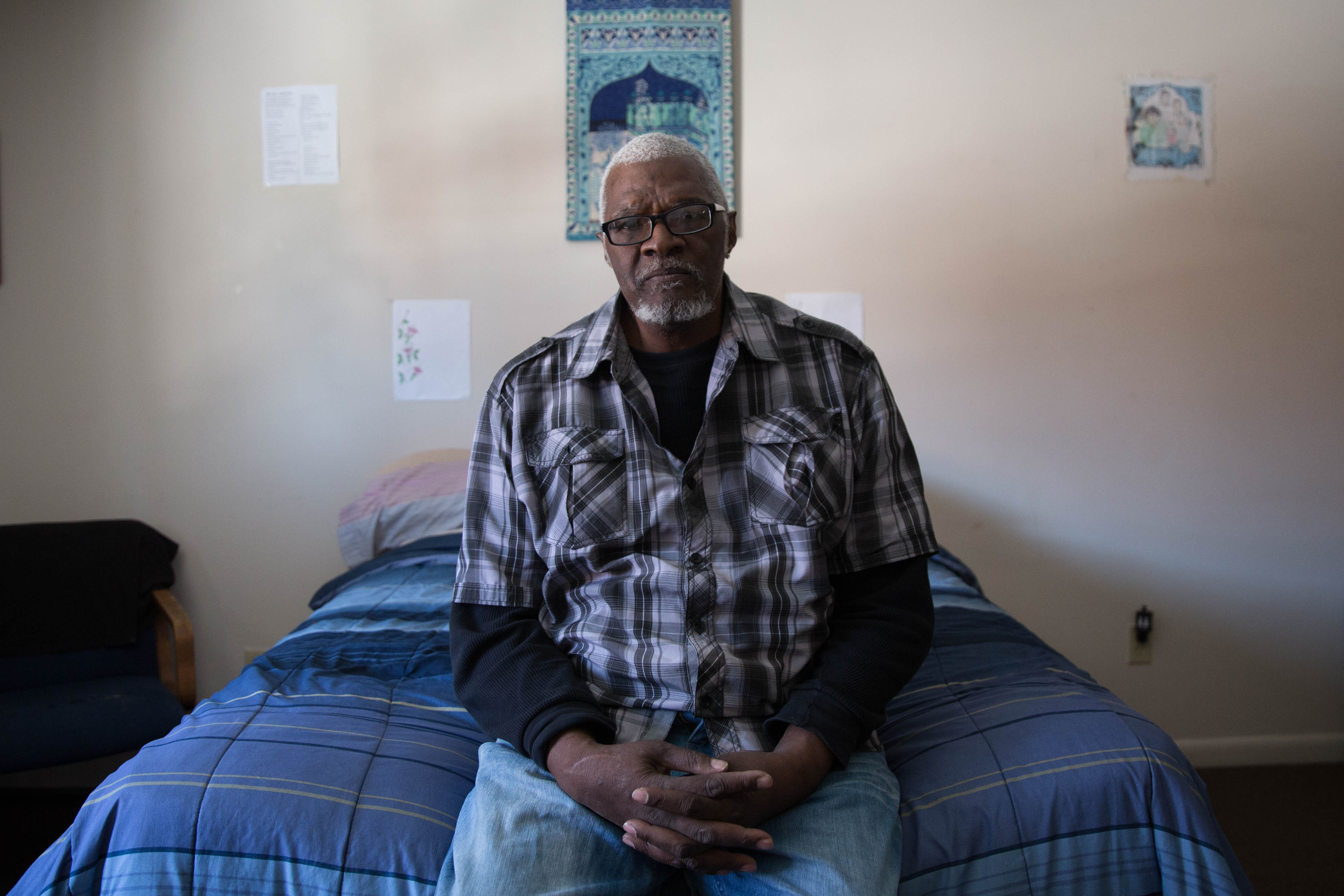Homeless, Addicted, and Overcoming a Long History of Neglect

Reggie Moton sits on the bed of his Hartford apartment. He was homeless for 20 years. Photo by Ryan Caron King for NENC
OPINION
When he leaves his apartment in Hartford, Connecticut’s historic Asylum Hill neighborhood, Reggie Moton, 62, has two choices.
He can turn right to Farmington Avenue, where he knows he can find people who could sell him drugs.
Or he can turn left, and go to Asylum Avenue — which, though it’s a busy street, doesn’t have the same business traffic.
He heads for Asylum.
Sara Capen Salomons is director of development and communications at Journey Home, a Connecticut-based nonprofit committed to ending homelessness. Her organization helped house Moton in January 2016, and she told Moton that “asylum” is another word for “refuge,” or “respite.”
Moton likes that.
“If I go to Farmington, I can get into all the things going on there,” said Moton. “I go left.”
That’s a hard-won realization for Moton, who spent 20 years living on the streets.
And in that, some parts of Moton’s life that — sadly — are entirely predictable. His life is a blueprint of what happens when we don’t provide for people who are mentally ill and addicted. Historically, we’ve let the Reggies flounder, and we’ve paid dearly for that.
The federal Substance Abuse and Mental Health Services Administration says that 20 to 25 percent of people who are homeless in the U.S. have some form of severe mental illness. Roughly the same percentage suffer from chronic substance abuse.
In Connecticut, according to the Connecticut Coalition to End Homelessness, about 29 percent of people who are homeless have substance abuse problems, and nearly 36 percent face mental health challenges. Nearly 18 percent of people who are homeless in Connecticut are living with both substance abuse issues and mental health challenges. These are often the toughest people to find, treat, and house. According to research, half of people who are diagnosed with severe mental illness also will be diagnosed with a substance abuse disorder.
During the time Moton was homeless, he spent time in jail, some time couch surfing, and some time drifting from one abandoned building to another. And then there were the shelters, which Moton found particularly challenging.
“Shelters,” he said, “are not counselors.” In addition to a substance abuse problem, Moton suffers from depression, which the National Alliance for Mental Illness says is the “leading cause of disability worldwide.” He has attempted suicide.
Being homeless is the worst state for someone who has a dual diagnosis of mental illness and substance abuse. Yet for years, the streets and shelters – and sometimes jails – have been what passes for our treatment centers. And neither jails nor shelters are equipped to handle the job.
This didn’t just happen. A series of failed public policies created an environment that effectively pushed people like Moton into homelessness. In times past – what some activists call the bad old days — he might have found a home in one of Connecticut’s state hospitals, which in a spirit of reform, began closing 30 years ago.

When Reggie first moved into his apartment, he only had a mattress and his fish tank. Photo by Ryan Caron King for NENC
The same spirit moved for closures in Massachusetts, Vermont, New Hampshire, and elsewhere. Beginning in the ’50s and stretching into the ’90s, new treatments for mental illness and an emphasis on deinstitutionalization moved a half million patients from state hospitals. Though support was scant for keeping open poorly-run hospitals such Mansfield Training Center in Connecticut or Augusta Mental Health Center in Maine, the institutions offered at least a modicum of stability to some patients.
From 1955, in Rhode Island, Massachusetts, New Hampshire and Vermont, the deinstitutionalization rates were over 95 percent. In Rhode Island, it was 98 percent – so for every 100 patients in 1955, there are now two.
In their place, cities and states offered a few community health centers – and homeless shelters, which were not equipped to handle the onslaught of clients and residents who were living with mental illness and addiction.
In December, the Spotlight investigative team at The Boston Globe said homeless shelters of the ’90s became “the new asylums” – little more than holding pens for people.
In the last two years, said the Globe, of the 1,500 people who are chronically homeless and had been assessed by the Massachusetts Housing and Shelter Alliance, 85 percent said they suffer from mental health problems.
A healthy dose of mental health and substance abuse community programs could cut that number significantly.
The recent failed Republican attempt at repealing and replacing Obamacare would have spelled disaster, say some advocates, for the nation’s growing interest in mental health care. The Affordable Care Act (Obamacare) includes mental health care parity – or the notion that insurance companies cover physical and mental health care equally. Nationally, a slew of bills aimed at improving our mental health care system await discussion, from a House bill that addresses counseling for female veterans, to a bill in the Senate that seeks to extend mental health screenings and assessments to youths entering foster care.
But even then, we have decades of neglect to correct.
Having his own place offers its a different kind of challenge, says Moton. He can babysit his granddaughters. He can talk to his daughters, and occasionally have buddies over for marathon chess matches (he learned in prison), but in the end, it’s him and four walls. He said he just started therapy – something he’d never considered before — and he intends to stick with it.
“God,” he says, “is still on the case.”
